Bound and Freely Propagating Gravity-Capillary Waves
New Insights into Radar Backscattering and Wave Damping
Measurements of the surface elevation and slope and of the backscattered radar power at X and Ka band were carried out with mechanically generated gravity waves as well as with wind waves on slick-free and slick-covered water surfaces. The measured radar Doppler shifts show that on a slick-free water surface, bound gravity-capillary (X and Ka band Bragg) waves are generated at the crests of steep gravity waves with frequencies between 3 and 5 Hz. However, steep gravity waves with a frequency of 2 Hz do not generate bound Ka band Bragg waves, and the Ka band backscattering from these waves is associated with wave breaking. In the wind speed range from 1.5 to 10 m/s, bound gravitycapillary waves contribute to the X and Ka band backscatter from slick-free water surfaces. The fraction of bound to freely propagating Bragg waves depends on, among other things, radar frequency, wind speed, wave amplitude of the dominant water wave, and slick coverage. In particular, the strong damping of the gravity waves by the slick at wind speeds of approximately 8 m/s leads to the disappearance of the bound Bragg waves and therefore to a reduction of the X and Ka band Doppler shifts to values corresponding to freely propagating Bragg waves. It is concluded that the study is pertinent to the understanding of former results of radar backscattering measurements in the presence of oceanic surface films.
References:
Gade, M., W. Alpers, S.A. Ermakov, H. Hühnerfuss, and P.A. Lange, 1998: Wind-wave tank measurements of bound and freely propagating short gravity-capillary waves, J. Geophys. Res., 103, 21697-21710.
Bound (Parasitic) Capillary Waves
Steep gravity waves on the water surface with wavelengths less than 0.5 m can generate short gravity-capillary waves near their crests, which then propagate along the steep forward wave slopes. Since they do not propagate with their own phase velocity but with the (higher) phase velocity of the generating (parent) wave, they are called bound or parasitic waves. Their generation is linked to the fact that large-amplitude gravity waves have non-sinusoidal profiles and thus contain higher order harmonics. These harmonics are bound waves which, in general, do not obey the dispersion relation for free gravity-capillary waves. They propagate with the phase velocity of the 0th-order (parent) wave and since the phase velocity of these parent gravity waves is higher than the minimum phase velocity of water waves, some high-order harmonics may satisfy the dispersion relation for gravitycapillary waves. The higher order harmonics are identical to free surface waves traveling at their intrinsic phase and group velocity, and they form a wave packet moving along the steep gravity wave profile.
![Generation of bound waves (after Ebuchi et al.[1987] Generation of bound waves (after Ebuchi et al.[1987]](/ifm/KFEW3O/WWK/WWT_Boundwaves?action=AttachFile&do=get&target=UHH_WWK_Bound_Ebuchi.gif)
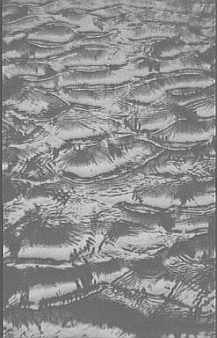
The upper left sketch schematically shows the high-vorticity region at the gravity wave's crest, at whose edge small capillary waves are generated [1]. The upper right picture was taken in the wind-wave tank with an upwind-looking digital video camera, when the reference wind speed was 5 m/s. Almost every gravity (decimeter) waves carries bound small-scale capillaries on its forward face (imaged area is about 50 cm x 150 cm).
References:
Ebuchi, N., H. Kawamura, and Y. Toba, 1987: Fine structure of laboratory wind-wave surfaces studied using an optical method, Bound. Layer Meteor., 39, 133-151.
Threshold Amplitude of Mechanically-Generated Waves
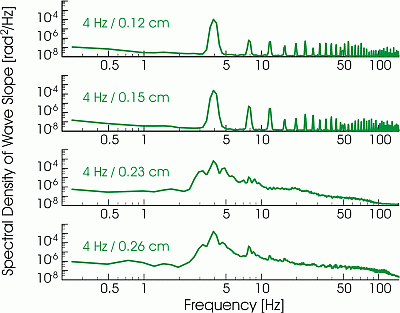
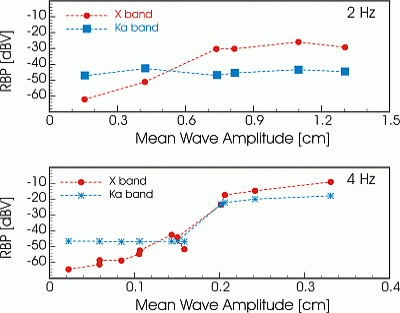
The excitation of bound (parasitic) gravity-capillary and capillary waves results in a strong change of the wave slope (and wave height) spectra, particularly, in the transition from a quasi-discrete to a continuous spectrum (see upper left figure). The dependencies of the X and Ka band relative backscattered power on the amplitude of the mechanically generated waves with wavelengths less than 30 cm, corresponding to frequencies higher than approximately 2.5 Hz, show a strong increase when the amplitude of the mechanically generated waves reaches a threshold value (upper right figure). This confirms that the backscattering can be associated with bound harmonics at X band and with bound capillary waves at Ka band.
Measurements of Radar Doppler Spectra
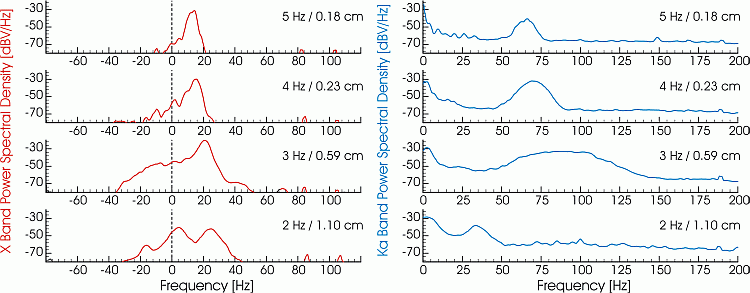
The occurrence of bound X and Ka band Bragg waves traveling at the phase velocity of the gravity waves is also shown by our measurements of the radar Doppler shifts. The upper figure shows radar Doppler spectra at X band (left) and Ka band (right) measured in the presence of mechanically-generated waves of increasing frequency. Steep gravity waves with wavelengths longer than approximately 30 cm, corresponding to frequencies lower than 2.5 Hz, cannot effectively generate bound capillary waves. The Ka band backscattering is then determined by the breaking of the steep gravity waves, and for X band it is caused by both bound harmonics and wave breaking.
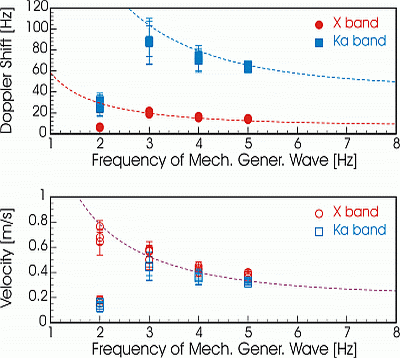
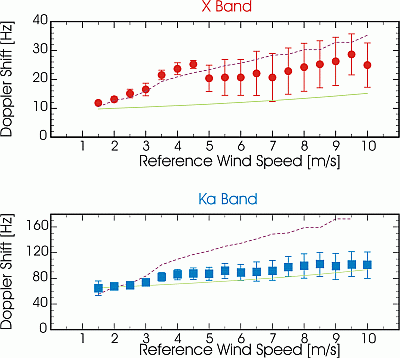
The results of our measurements with mechanically generated waves (left) agree well with those performed with wind-generated waves (right): from the radar Doppler spectra we conclude that the X band backscattering from a slick-free water surface at low wind speeds (up to approximately 4.5 m/s) and long fetches (15.5 m in our investigation) is determined mainly by bound waves, whereas the Ka band backscatter is caused by both bound and freely propagating Bragg waves. For wind speeds higher than 4.5 m/s the X band backscattering in our experiments is caused by both parasitic harmonics and freely propagating Bragg waves, whereas the Ka band backscatter is caused mainly by freely propagating Bragg waves. In particular, the generation of freely propagating wind waves results in a reduction of the X band Doppler shift at wind speeds of 4.5-5 m/s, which is less distinct at Ka band.
Slick-Covered Water Surface
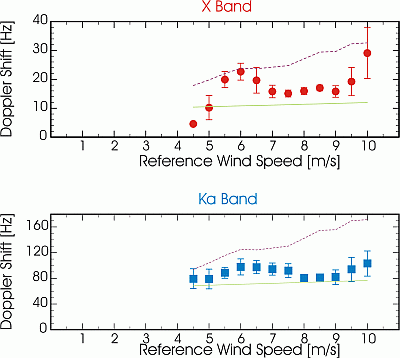
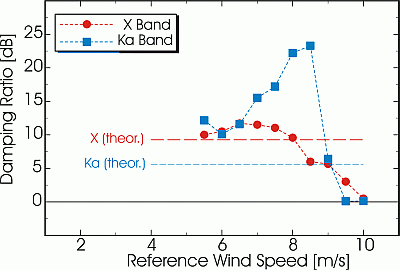
The measurements of the X and Ka band backscatter from wind-generated waves on a water surface covered with oleyl alcohol (OLA) show that the coverage of the water surface with a surface-active substance has a strong influence on the generation of bound waves at the crests of the gravity waves. At intermediate wind speeds of approximately 6 m/s the X band backscatter is mainly caused by bound Bragg waves, and the Ka band backscatter is mainly caused by both bound and freely propagating Bragg waves. In the wind speed range between 7 and 9 m/s, where the short gravity waves are strongly damped by the OLA slick, both the X and Ka band backscatter are caused only by freely propagating waves. This wave damping behavior of the OLA slick can explain the maximum damping of the radar backscatter in this particular wind speed range as well as the fact that the measured wave damping exceeds the values predicted by Marangoni damping theory for this (water wave) frequency range (see the upper right panel).

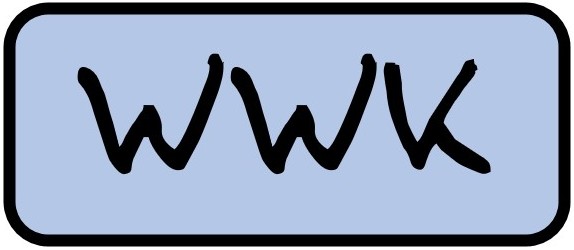 .. back to the Wind-Wave Tank page...
.. back to the Wind-Wave Tank page... 
 .. or to the KFEW3O page ...
.. or to the KFEW3O page ...
